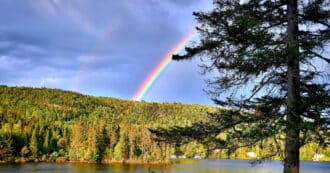By Matthew Mausner – Creating a functioning ecosystem used to be considered only within the scope of the divine. Human scientific and engineering abilities have advanced to the point now that we modify, alter, or even attempt to reconstruct or even create whole ecosystems… sometimes with ideas that are actual science fiction. The issues inherent in a world industrial civilization of 8 billion people, including possible catastrophic ways that civilization is interacting with nature, push us to explore and contemplate large-scale ecological engineering to meet these challenges in imaginative ways.
The Origins of Ecological Engineering
The famous scientist Freeman Dyson was known for proposing elaborate ideas to use human engineering capabilities to expand our habitable ecosystems. He proposed seeding comets with genetically engineered ‘trees’ and hollow out a habitat humans could live in, and his thought experiments shaped many proposed means of sustainable space exploration with a portable natural environment. His proposals for genetically engineered microorganisms were aimed to support and expand our resource base, restore a rural village self-sufficiency pattern, be solar-powered, and reduce inequality, for which he coined the term ‘green technology‘.
Other scientists including Howard Odum, Mitsch, and Jorgensen followed his lead and helped formally establish the field of ‘ecological engineering’ in the 1960s.
Is Ecological Engineering Science Fiction?
An even more all-encompassing idea of his took his name: the Dyson Sphere, where a civilization would build a whole sphere, at the distance of earth’s orbit, from its sun, to capture as much as possible of its life-giving solar energy, and expand its civilization all across the vast surface of this inward-facing sphere (Dyson himself credited part of the inspiration to a 1937 early sci-fi novel ‘Star Maker‘ by Olaf Stapledon).
This inspired the classic Larry Niven science fiction book ‘Ringworld‘, where a beyond-human civilization had engineered a massive ‘ring’ to completely encircle their sun, and expand the habitat for its humans to an area of a million earths. Science fiction authors’ ideas have often inspired ecological engineering ideas, including Arthur C. Clarke’s rotating-garden spaceship in ‘Rendezvous with Rama‘, Nicole Griffith’s elaborate recycling and detoxifying technologies in ‘Slow River‘, and many others.
Ecological Engineering Becomes Reality!
Yet, now these ideas are far more than science fiction. Civilizations have engineered massive changes to ecosystems for many millennia, creating canals and dams for water and irrigation, draining ‘swamps’ (now we call them ‘wetlands’), turning garbage dumps into man-made mountains, planting forests and orchards, and otherwise significantly altering the environment. Today’s ecological engineering is often similar but scaled up and more technological.
Examples of Ecological Engineering
Sometimes ecological engineering is aimed at creatively expanding artificial habitats for people, like the Palm Islands of Dubai.
Other times it is aimed at restoring ecosystems, hoping to stave off or repair a human-created disaster, like the joint Jordanian-Israeli plans to refill the Dead Sea by opening water flow from the Red Sea.
It can also be used in vast experiments to address much vaster crises, like the specially designed trawlers seeking to scoop up the waste floating in the great Pacific plastic garbage patch, attempts to genetically engineer plastic-eating fungus to deal with our massive plastic global pollution problems, or the Bill Gates-sponsored attempts to spray sunlight-reflecting particles high into the atmosphere to slow or head off global warming.
A Belief in Ecological Technology
There is considerable optimism from some people that such elaborate and advanced technological ideas will indeed solve our problems. This techno-philia is not entirely groundless: ‘necessity is the mother of invention’, and indeed ingenuity has solved massive problems that we thought were unsolvable.
For example, the eternal issues civilizations had with recurrent famines were addressed with innovations like artificial fertilizers, fixing nitrogen, refrigeration and preserving, and global food transportation, which has enabled us to vastly scale up our population since the late 1800s.
Vaccine technologies have nearly wiped out pathogens that were perpetually dangerous and were thought to be endemic to human populations. And the massive yet routine ecological engineering projects we call ‘sanitation’– e.g. clean water infrastructure and sewage systems — may be responsible, more than any other single cause, for the expansion and safety of the earth’s population.

Ecological Restoration
Restoring ecosystems may not entirely be a pipe dream. To integrate human society with its natural activities of today’s unprecedented populations and their technologies and needs, into the web of nature, takes ever more ingenuity and engineering. The design of sustainable large-scale alterations of the natural environment to repair or restore, or even the restoration of ecosystems, is at least theoretically within our reach, according to the more ambitious visions. Many such initiatives are engineering ecological ecosystem restoration solutions on a large scale all over the world.
Places like the Great Plains of the US rebuilt some of their topsoil after the ‘Dust Bowl’ era of the 1930s, using technologies like artificial fertilizer and other industrial agriculture techniques, but the constant need for more and more additives make it questionable whether these engineering principles work in the long run.
High levels of pollution have already affected our entire global ecosystem, and some approaches are being tried to address or reverse these trends. Seeding or ‘fertilizing‘ the ocean with iron micro-particles to stimulate green phytoplankton growth is one, with the goals to capture carbon and lower or reverse acidification, and therefore restore a healthier ocean ecosystem.
While this may be relatively inexpensive compared to some of the more elaborate ecological engineering solutions proposed, the experiments done so far have generated doubts about whether it could actually be effective in the ways hoped for.
Similarly, there are attempts to spray micro-particles high in the atmosphere to reduce greenhouse effects, solar radiation, and thus ameliorate global warming. One such experiment is a proposal to put calcium carbonate into the stratosphere, to reflect more light and possibly also trap less heat.
However, even that project’s proponents acknowledge that since calcium carbonate isn’t usually found in the stratosphere, there are unknown risks.

The Arrogance of Ecological Engineering
As many thinkers, including David Ehrenfeld, have pointed out, there’s an arrogance in overestimating our technological capabilities, and conveniently forgetting the many times and ways our interventions in the environment have led to collapse and ruin. Technology should be thought of as guilty until proven innocent, as Jerry Mander’s book ‘In the Absence of The Sacred’ suggests.
Too often, the predictions and projections turn out to be wrong, even disastrously wrong, especially about systemic risks like to cod populations in the 1960s, effects of fracking in Pennsylvania and New York, the safety of BP’s Deepwater Horizon offshore drilling platform, the safety of the Chernobyl and Fukushima nuclear reactors, and many more.
Even the nuclear engineering prowess of the Japanese failed in the face of a predictable natural disaster.
Ecological Engineering Solutions For Our Global Ecosystem
All the more so is this the case when massive technological ‘solutions’ are proposed to address major society-generated imbalances in our ecosystems. There are three entirely different levels of problems with this approach.
One level is, determining whether or not the ‘solutions’ actually could work, or are worthwhile, considering the scale of investment needed (often gargantuan, as in carbon…).
The second is whether the alleged promise of such solutions to human activities, and the faith in them, incorrectly incentivizes our technophilic civilization to postpone changing the destructive habits which caused the problems in the first place, imagining that ‘technology will save us’.
And then the third level would say… what choice/s do we have besides attempting such massive interventions to prevent our own self-destruction? Ecological engineering by its very nature is large scale and dealing with chaotic natural systems. We may not have an opportunity to do controlled and patient experiments within the time frame within which civilization-caused damage to the earth’s ecosystem has any chance of stopping before becoming irreversibly catastrophic.
Paul Hawken and Stewart Brand are two of the most prominent articulators of research into cost accounting, where economic ‘externalities’ must be included in the ‘true cost accounting‘ of any given idea, project, technology, company, or economy.
We are facing a crisis too large and comprehensive to avoid thinking of things holistically: we must be clear-minded and practical, and yet also move quickly, in moving towards a more sustainable and achievable future.
Ecological engineering, even on the vastest scale, is something we must entertain as one of the critical management tools to face up to the unprecedented challenges of our current predicament.
* Featured image source
Follow this link to learn more about Ecological Balance.





